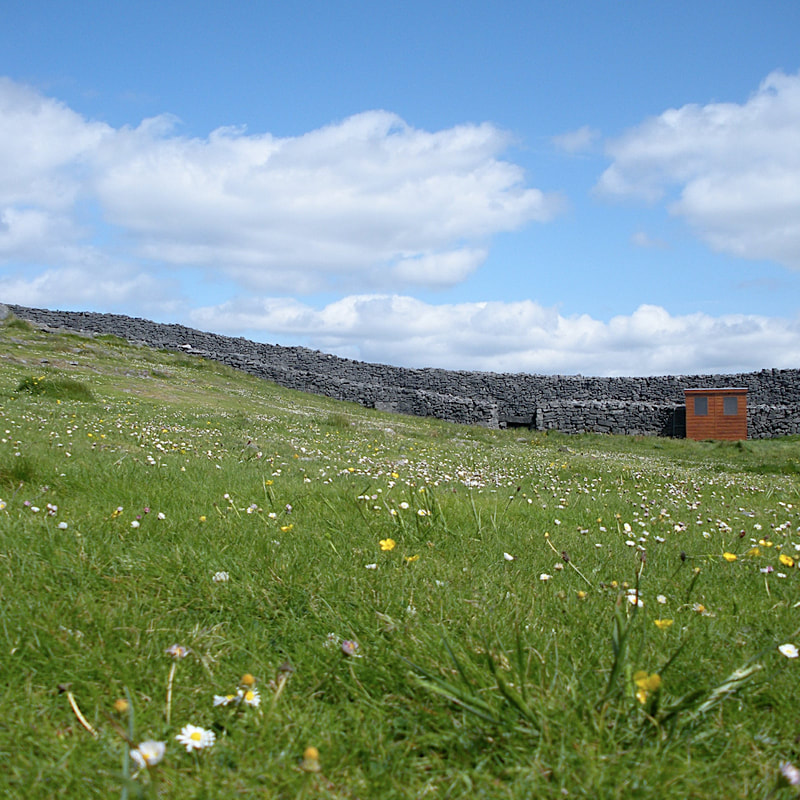|
I’ve wanted to go to the Aran Islands since I was a little girl. I think I read a book about them, where the protagonist was a red-haired girl wearing big, fluffy wool sweaters living in a thatch-roofed house on a lonely cliff overlooking the Atlantic Ocean. I don’t remember the title or what the book was even about, but I remember that there were sheep and magical creatures and wave pounded coasts and, well, I was smitten. Twenty-some years later, I finally made it to the Aran Islands—and to Ireland—on a grown-up family vacation, and in more ways than one (the trials of a family vacation…that’s a topic for another post!), I was transported back to my little girl self who dreamed about the Arans while burying my nose in yet another magical novel. My mother, sister and I just got home from a two-week vacation in Ireland. Eire was everything I imagined, which was a tall order for a little island. The Guinness overflowed from my pint glass nightly, Uilleann pipes and penny whistles were our soundtrack in pub after pub and highway after highway, and the hills and coasts were as spectacularly green as I’d been told they were. We were inundated by historical tales from the nation’s infamous story tellers—multiple versions of Brian Boru’s ascent to the Irish crown, of why there are stonewalls criss-crossing the island, and of how and when Guinness was invented. While my mom fixated on England’s indelible and painful marks on the island, and while E. was aghast at how many tombs in Ireland had been excavated, I was enraptured with the ancient history…the really ancient history. Having traveled in Central America and India and Southeast Asia and Southern Africa—and dreaming of travels to the Middle East and the Andes and our own American Southwest—I’ve always thought of ancient history (you know, the gagillion years BC history) as something that belonged to other people and other cultures. My history—the history of my European ancestors—while interesting, was stuck more in the Middle Ages and the Colonial Ages and the Renaissance. Interesting, yes, but as impressive as everything that came before? Not so much. Shows how little I know. Ireland is dotted—no, covered—in ridiculously old ruins. 3000 BC ruins, like the passage tombs of Newgrange and the Boyne River Valley and the dolmens and cairns and huts that litter the Burren’s limestone fields. Iron Age ruins, like the ring forts of the Aran Islands. Castles and cathedrals and abbeys and coronation sites that are a thousand years old, built on top of castles and forts and religious centers and druidic strongholds that are another thousand or more years old. And unlike their more contemporary cousins, these ‘ruins’ are not exactly ruins. They’re in tact, millennia later. The roof at Newgrange, around five thousand years old, is still completely waterproof. The fort at Dun Aengus, around three thousand years old and built without mortar, still huddles around a precarious cliff face on the Atlantic. The dolmens of the Burren and the henges that dot the countryside still stand upright, uncracked and unwobbly. As our guide at Newgrange proudly declared, these people were smart. Not the dense-headed Neanderthals living in caves and pounding their bare chests that we usually imagine—but architects, engineers, astronomers. Thinkers, planners, builders. Their creations and recreations (like the landscape of Ireland, now mostly bogland thanks to the Neolithic farmers who burned Ireland’s native pine forests) have proven more permanent than our own twenty-first century doings. Perhaps we just can’t be bothered…? As a kid, I hated ancient history. (Really, I hated any history—I’d rather keep my nose buried in some magical, fantastical novel than learn anything about what actually happened in the world.) Now, I can’t get enough of it—even moreso when I feel that some of this is my ancient history. Of course, I indulged in modern Irish culture, too—pubs every night, strolls through vibrant cities like Galway, hikes in Ireland’s national parks, and seafood meals to die for (and butter and cheese and sausages and…Ireland is so much more than potatoes). I partook of the craic whenever I could—at McDiarmid’s pub in Doolin, where a young Irishman urged me to comeback for Lisdoonvarna’s annual matchmaking festival; at the National Museum of Ireland, where the security guard donned a donkey nose and tried to piece together our Irish genealogy; and in the middle of the street in Galway, as a frazzled woman walked past with an antique commode. The craic, the pints, the food, the cities, the roads, the views—all were spectacular, and just as every visitor to Ireland has described them. But the tombs of Newgrange, the dolmens of the Burren, the forts that taunt the Atlantic to pound harder and higher—this is the Ireland that will haunt me. That red-headed Aran Island girl I dreamed about as a child is even more enrapturing now—now that I’ve imagined her the descendent of Dun Aengus’s builders, living in one of those wind-battered white houses at the base of the fort, side-by-side with her own ancient ancestry.
0 Comments
Leave a Reply. |
AboutWhile living in Mexico, I joked that speaking Spanish forced me to be far more Zen about life: Since I could only speak in the present tense, I was forced to just live in that present tense. Archives
October 2023
Categories
All
photosLike what you see? That's mostly Ross Freshwater. Check out my talented partner-in-life's photo gallery. |

 RSS Feed
RSS Feed